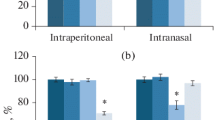Abstract
The effects of the peripherally administered neuropeptide substance P (SP) on spatial learning capacities were investigated in 27-month-old rats using a water-maze task. Old rats were injected intraperitoneally once daily for 6 days with 50 or 250 µg/kg SP or vehicle 30 min prior to acquisition trials. Improvement in maze performance was observed following injections of 250 µg/kg SP only. Furthermore, vehicle-treated old rats showed significantly poorer acquisition rates than vehicle-treated 12-week-old rats. Thus, the improvement in performance after the 250 µg/kg dose of SP can be interpreted in terms of a compensation of performance deficit in the old rats.
Similar content being viewed by others
References
Banks WA, Kastin AJ (1985) Peptides and the blood-brain barrier: lipophilicity as a predictor of permeability. Brain Res Bull 15:287–292
Barnea A, Cho G, Porter JC (1982) A reduction in the concentration of immunoreactive corticotropin, melanotropin and lipotropin in the brain of the aging rat. Brain Res 232:345–353
Barnes CA, Nadel L, Honig WK (1980) Spatial memory deficit in senescent rats. Can J Psychol 34:29–39
Cooper RL, McNamara MC, Thompson WG, Marsh GR (1980) Vasopressin modulation of learning and memory in the rat. In: Poon L (ed) Aging in the 1980's: selected contemporary issue in psychobiology of aging. American Psychological Association, Washington, pp 201–211
De Ceballos ML, Boyce S, Taylor M, Jenner P, Marsden CD (1987) Age-related decreases in the concentration of Met- and Leuenkephalin and neurotensin in the basal ganglia of rats. Neurosci Lett 75:113–117
De Wied D, van Ree JM (1982) Neuropeptides, mental performance and aging. Life Sci 31:709–719
Dorsa DM, Bottemiller L (1982) Age-related changes of vasopressin content of microdissected areas of the rat brain. Brain Res 242:151–156
Dupont A, Savard P, Merand Y, Labrie F, Boissier JR (1981) Age-related changes in central nervous system enkephalins and substance P. Life Sci 29:2317–2322
Edvinsson L, McCulloch J, Rosell S, Uddman R (1982) Antagonism by (d-Pro2,d-Trp7, 9)-substance P of the cerebrovascular dilatation induced by substance P. Acta Physiol Scand 116:411–416
Gallagher M, Pelleymounter MA (1988) Spatial learning deficits in old rats: a model for memory decline in the aged. Neurobiol Aging 9:549–556
Gallagher M, Bostock E, King R (1985) Effects of opiate antagonists on spatial memory in young and aged rats. Behav Neural Biol 44:374–385
Giurgea C, Mouravieff-Lesuisse F (1972) Effect facilitateur du piracetam sur un apprentissage repetitif chez le rat. J Pharmacol (Paris) 3:17–30
Hasenöhrl RU, Gerhardt P, Huston JP (1990) Substance P enhancement of inhibitory avoidance learning: mediation by the N-terminal sequence. Peptides (in press)
Hock FJ (1987) Drug influences on learning and memory in aged animals and humans. Neuropsychobiology 17:145–160
Huston JP, Stäubli U (1981) Substance P and its effects on learning and memory. In: Martinez JL, Jensen RA, Messing RB, Rigter H, McGaugh JL (eds) Endogenous peptides and learning and memory processes. Academic Press, New York, pp 521–540
Huston JP, Oitzl M-S (1989) On the relationship between reinforcement and memory: parallels in the rewarding and mnemonic effects of the neuropeptide substance P. Neurosci Biobehav Rev 13:171–180
Ingram DK (1985) Analysis of age-related impairments in learning and memory in rodent models. Ann NY Acad Sci 444:312–331
Klugman KP, Lembeck F, Markowitz S, Mitchell G, Rosendorff C (1980) Substance P increases hypothalamic blood flow via an indirect adrenergic-cholinergic interaction. Br J Pharmacol 71:623–629
Krause JE (1985) On the physiological metabolism of substance P. In: Jordan CC, Oehme P (eds) Substance P: metabolism and biological actions. Taylor and Francis, London, pp 13–30
Krauth J (1980) Nonparametric analysis of response curves. J Neurosci Methods 2:239–252
Kubanis P, Zornetzer SF (1981) Age-related behavioral and neurobiological changes: a review with an emphasis on memory. Behav Neural Biol 31:115–172
Lüneburg U, Flohr H (1988) Effect of substance P on vestibular compensation. In: Flohr H (ed) Post-lesion neural plasticity. Springer-Verlag, Berlin Heidelberg New York, pp 699–704
Oitzl M-S, Hasenöhrl RU, Huston JP (1990) Evidence for reinforcing effects of peripherally administered substance P and its C-terminal sequence pGlu6-SP-6-11 in the rat. Psychopharmacology (in press)
Pelleymounter MA, Smith MY, Gallagher M (1987) Spatial learning impairments in aged rats trained with a salient configuration of stimuli. Psychobiology 15:248–254
Rigter H, Veldhuis HD, de Kloet ER (1984) Spatial learning and the hippocampal corticosterone receptor system of old rats: effect of the ACTH4–9 analogue Org 2766. Brain Res 309:393–398
Schuurman T, Horvath E, Spencer DG, Traber J (1986) Old rats: an animal model for senile dementia. In: Bès A (ed) Senile dementias: early detection. John Libbey Eurotext, Paris, pp 624–630
Stern P, Hadzovic J (1973) Pharmacological analysis of central actions of synthetic substance P. Arch Int Pharmacodyn 202:259–262
Tomaz C, Huston JP (1986) Facilitation of conditioned inhibitory avoidance by post-trial peripheral injection of substance P. Pharmacol Biochem Behav 25:469–472
Zornetzer SF, Thompson R, Rogers J (1982) Rapid forgetting in aged rats. Behav Neural Biol 36:49–60
Author information
Authors and Affiliations
Rights and permissions
About this article
Cite this article
Hasenöhrl, R.U., Huston, J.P. & Schuurman, T. Neuropeptide substance P improves water maze performance in aged rats. Psychopharmacology 101, 23–26 (1990). https://doi.org/10.1007/BF02253712
Received:
Revised:
Issue Date:
DOI: https://doi.org/10.1007/BF02253712




